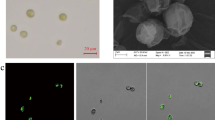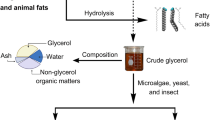Abstract
The research work was aimed to produce 2-monoacylglycerol rich omega-3 polyunsaturated fatty acids from supercritical carbon dioxide (SC-CO2) extracted Atlantic salmon frame bone oil (SFBO) by using sn-1,3 lipase catalyzed ethanolysis. SFBO was extracted by SC-CO2 at 45 °C, 25 MPa at carbon dioxide flow rate of 27 g/min for 3 h. Four sn-1,3 specific immobilized lipases namely Novozym-435, Lipozyme TLIM, Lipozyme RMIM, and Lipase DF were screened to evaluate the efficiency of catalyzing ethanolysis reaction for 2-monoacylglycerol production. Response surface methodology (RSM) was applied to optimize ethanolysis parameters such as reaction temperature, time, enzyme load, and ethanol: oil molar ratio to maximize 2-monoacylglycerol production. Salmon frame bone was found rich in oil and the yield was 35.15% in supercritical CO2 extraction. Lipozyme TLIM showed the highest catalyzing activity for 2-monoacylglycerol production from SFBO. The optimum reaction temperature, time, enzyme load, and ethanol: oil molar ratio determined by RSM were 42.5 °C, 4.15 h, 42.81%, and 49.82, respectively at which the yield of 2-monoacylglycerol was 41.81%. Thin layer chromatography analysis proved that the solvent extraction process performed in this study for the separation and purification of 2-MAG from ethanolysis reaction products was successful. The ω-3 polyunsaturated fatty acids content was found 21.34% in 2-monoacylglycerol whereas SC-CO2 extracted SFBO contained 11.25%. Production of 2-monoacylglycerol by ethanolysis reaction of SFBO at the optimized conditions with Lipozyme TLIM may be an efficient approach for human food supplement and potential for food and pharmaceutical industry.
Graphical Abstract






Similar content being viewed by others
References
del Mar Muñío, M., Esteban, L., Robles, A., Hita, E., Jiménez, M.J., González, P.A., Molina, E.: Synthesis of 2-monoacylglycerols rich in polyunsaturated fatty acids by ethanolysis of fish oil catalyzed by 1, 3 specific lipases. Process Biochem. 43(10), 1033–1039 (2008)
Esteban, L., del Mar Muñío, M., Robles, A., Hita, E., Jiménez, M.J., González, P.A., Molina, E.: Synthesis of 2-monoacylglycerols (2-MAG) by enzymatic alcoholysis of fish oils using different reactor types. Biochem. Eng. J. 44(2), 271–279 (2009)
Rodríguez, A., Esteban, L., Martín, L., Jiménez, M.J., Hita, E., Castillo, B., Robles, A.: Synthesis of 2-monoacylglycerols and structured triacylglycerols rich in polyunsaturated fatty acids by enzyme catalyzed reactions. Enzyme Microb. Tech. 51(3), 148–155 (2012)
Solaesa, ÁG., Sanz, M.T., Falkeborg, M., Beltrán, S., Guo, Z.: Production and concentration of monoacylglycerols rich in omega-3 polyunsaturated fatty acids by enzymatic glycerolysis and molecular distillation. Food Chem. 190, 960–967 (2016)
Liaset, B., Nortvedt, R., Lied, E., Espe, M.: Studies on the nitrogen recovery in enzymic hydrolysis of Atlantic salmon (Salmo salar, L.) frames by Protamex™ protease. Process Biochem. 37, 1263–1269 (2002)
Routray, W., Dave, D., Ramakrishnan, V.V., Murphy, W.: Production of high quality fish oil by enzymatic protein hydrolysis from cultured Atlantic salmon by-products: Investigation on effect of various extraction parameters using central composite rotatable design. Waste Biomass Valori. https://doi.org/10.1007/s12649-017-9998-6 (2017)
Haq, M., Ahmed, R., Cho, Y.J., Chun, B.S.: Quality properties and bio-potentiality of edible oils from Atlantic salmon by-products extracted by supercritical carbon dioxide and conventional methods. Waste Biomass Valori. 8(6), 1953–1967 (2017)
Hernandez, E.M.: Issues in fortification and analysis of omega-3 fatty acids in foods. Lipid Tech. 26(5), 103–106 (2014)
Fregolente, L.V., Batistella, C.B., Maciel Filho, R., Maciel, W.: M.R.: Optimization of distilled monoglycerides production. Appl. Biochem. Biotech. 131, 680–693 (2006)
Mohammadi, M., Habibi, Z., Dezvarei, S., Yousefi, M., Ashjari, M.: Selective enrichment of polyunsaturated fatty acids by hydrolysis of fish oil using immobilized and stabilized Rhizomucor miehei lipase preparations. Food Bioprod. Process. 94, 414–421 (2015)
Feltes, M.M.C., de Oliveira, D., Block, J.M., Ninow, J.L.: The production, benefits, and applications of monoacylglycerols and diacylglycerols of nutritional interest. Food Bioprocess Tech. 6(1), 17–35 (2013)
Valverde, L.M., Moreno, P.A.G., Callejón, M.J.J., Cerdán, L.E., Medina, A.R.: Concentration of eicosapentaenoic acid (EPA) by selective alcoholysis catalyzed by lipases. Eur. J. Lipid Sci. Tech. 115(9), 990–1004 (2013)
Vaysse, L., Ly, A., Moulin, G., Dubreucq, E.: Chain-length selectivity of various lipases during hydrolysis, esterification and alcoholysis in biphasic aqueous medium. Enzyme Microb. Tech. 31(5), 648–655 (2002)
Janssen, A.E.M., Sjursnes, B.J., Vakurov, A.V., Halling, P.J.: Kinetics of lipase-catalyzed esterification in organic media: correct model and solvent effects on parameters. Enzyme Microb. Tech. 24, 463–470 (1999)
Baş, D., Boyacı, İH.: Modeling and optimization I: Usability of response surface methodology. J. Food Eng. 78(3), 836–845 (2007)
Getachew, A.T., Chun, B.S.: Optimization of coffee oil flavor encapsulation using response surface methodology. LWT-Food Sci. Technol. 70, 126–134 (2016)
Keskin, H., Koçak Yanık, D., Mucuk, H.N., Göğüş, F., Fadıloğlu, S.: Valorization of olive pomace oil with enzymatic synthesis of 2-monoacylglycerol. J. Food Sci. 81(4) (2016)
Myers, R.H., Montgomery, D.C., Christine, M.: Response Surface Methodology: Process and Product Optimization Using Designed Experiments. Wiley, New Jersey p. 705. (2009)
Rubio-Rodriguez, N., de Diego, S.M., Beltran, S., Jaime, I., Sanz, M.T., Rovira, J.: Supercritical fluid extraction of the omeg-3 rich oil contained in hake (Merluccius capensis-Merluccius paradoxus) byproducts: study of the influence of process parameters on the extraction yield and oil quality. J. Supercrit. Fluids 47, 215–226 (2008)
Lee, H.J., Haq, M., Saravana, P.S., Cho, Y.N., Chun, B.S.: Omega-3 fatty acids concentrate production by enzyme-catalyzed ethanolysis of supercritical CO2 extracted oyster oil. Biotechnol. Bioprocess Eng. 22(5), 518–528 (2017)
Gan, C.Y., Latiff, A.A.: Optimisation of the solvent extraction of bioactive compounds from Parkia speciosa pod using response surface methodology. Food Chem. 124, 1277–1283 (2011)
Derringer, G.: Simultaneous optimization of several response variables. J. Qual. Technol. 12, 214–219 (1980)
AOCS: Official Method Ce 2–66. Fatty acid composition by gas chromatography. Champaign-Urbana. American Oil Chemists’ Society, Illinois (2006)
Haq, M., Park, S.K., Kim, M.J., Cho, Y.J., Chun, B.S.: Modifications of Atlantic salmon by-product oil for obtaining different ω-3 polyunsaturated fatty acids concentrates: an approach to comparative analysis. J. Food Drug Anal. 26, 545–556 (2018)
Weber, N., Mukherjee, K.D.: Lipid Biotechnology. In: Akoh, C.C., Min, D.B. (eds.) Food lipids: chemistry, nutrition, and biotechnology, 3rd edn., pp 708–767. CRC Press, Boca Raton (2008)
Parkin, K.L.: Enzymes. In: Damodaran, S., Parkin, K.L., Fennema, O.R. (eds.) Fennema’s food chemistry, 4th edn., p.p 331–437. CRC Press, Boca Raton (2007)
Bucio, S.L., Solaesa, ÁG., Sanz, M.T., Melgosa, R., Beltrán, S., Sovová, H.: Kinetic study for the ethanolysis of fish oil catalyzed by lipozyme® 435 in different reaction media. J. Oleo Sci. 64, 431–441 (2015)
Akoh, C.C., Chang, S.S., Lee, G.G., Shaw, J.J.: Enzymatic approach to biodiesel production. J. Agric. Food Chem. 55, 8995–9005 (2007)
Shimada, Y., Ogawa, J., Watanabe, Y., Nagao, T., Kawashima, A., Kobayashi, T., Shimizu, S.: Regiospecific analysis by ethanolysis of oil with immobilized Candida antarctica lipase. Lipids 38, 1281–1286 (2003)
Adamczak, M., Bornscheuer, U.T.: Application of medium engineering in the synthesis of structured triacylglycerols from evening primrose oil (Oenotherabiennis L.). Eur. J. Lipid Sci. Tech. 115, 405–412 (2013)
Valverde, L.M., Moreno, P.G., Quevedo, A.R., Peña, E.H., Callejón, M.J., Cerdán, L.E., … Medina, A.R.: Concentration of docosahexaenoic acid (DHA) by selective alcoholysis catalyzed by lipases. J. Am. Oil Chem. Soc. 89(9), 1633–1645 (2012)
Shimada, Y., Watanabe, Y., Sugihara, A., Tominaga, Y.: Enzymatic alcoholysis for biodiesel fuel production and application of the reaction to oil processing. J. Mol. Catal. B Enzym. 17, 133–142 (2002)
Wang, X., Liang, L., Jin, YuZ.R.L., Wang, Q.: X.: Scalable synthesis of highly pure 2-monoolein by enzymatic ethanolysis. Eur. J. Lipid Sci. Tech. 116(5), 627–634 (2014)
Haq, M., Getachew, A.T., Saravana, P.S., Cho, Y.J., Park, S.K., Kim, M.J., Chun, B.S.: Effects of process parameters on EPA and DHA concentrate production from Atlantic salmon by-product oil: Optimization and characterization. Korean J. Chem. Eng. 34, 2255–2264 (2017)
Baeza-Jimenez, R., Lopez-Martinez, L.X., Garcia, H.S.: Biocatalytic modification of food lipids: reactions and applications. Rev. Mex. Ing. Quim. 13, 29–47 (2014)
Acknowledgements
This work was supported by Business for Cooperative R&D (Grant No. C0350298) between Industry, Academy, and Research Institute funded Korea Small and Medium Business Administration in 2015.
Author information
Authors and Affiliations
Corresponding author
Rights and permissions
About this article
Cite this article
Haq, M., Pendleton, P. & Chun, BS. Utilization of Atlantic Salmon By-product Oil for Omega-3 Fatty Acids Rich 2-Monoacylglycerol Production: Optimization of Enzymatic Reaction Parameters. Waste Biomass Valor 11, 153–163 (2020). https://doi.org/10.1007/s12649-018-0392-9
Received:
Accepted:
Published:
Issue Date:
DOI: https://doi.org/10.1007/s12649-018-0392-9




